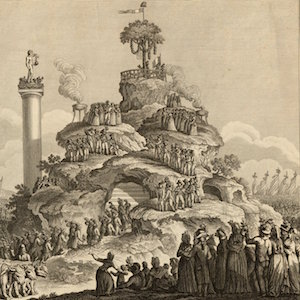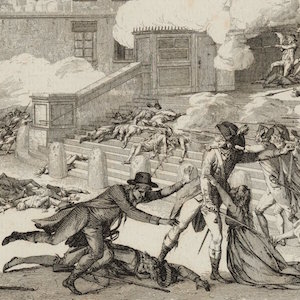Early Modern (1450 CE - 1800 CE)

Last Meeting of Louis XVI with His Family at the Temple Prison
Another version of the final meeting of the King with his family. To the left is his confessor; the figure to the right is most likely Cléry, the King’s valet.

Louis Leaves His Family
What links the many scenes we have of the King and his family is the modern sensibility on display in all of them. Of course, since dates are uncertain, we must assume that several images hail from the nineteenth century. Yet all confirm the sentimentality that the twentieth century so embraces.

Louis’s Separation from His Family
After hearing the verdict, the King was allowed a final evening with his family, whom he had not seen for almost a month during the trial. Twice on the evening of 20 January the King met with his wife, his son, and a daughter. For about an hour and three–quarters all told, they visited.

Louis as Pig
The Queen, never popular to begin with in France, also bore the brunt of popular anger in 1792, as seen in these images of the King, the Queen, and elsewhere the entire royal family, as animals.

Marie Antoinette as a Serpent
The Queen, never popular to begin with in France, also bore the brunt of popular anger in 1792, as seen in these images of the King, Queen, and elsewhere the entire royal family, as animals.

Image of the Attack of 20 June 1792
By the spring of 1792, the Revolution was in crisis on several fronts—in April, war had been declared on the Habsburg Empire, uprisings were taking place in provincial cities, and the Legislative Assembly was increasingly divided over whether to consolidate gains already made or press forward wit

The King Accepting the Constitution amid the National Assembly, 14 September 1791
The Estates–General, reborn as the National Assembly, finished its work by completing a new constitution. This document provided for an executive—the King—as well as a legislative body. Suffrage was male and restricted to certain economic levels.

View of the Mound of Champ de la Reunion
In this watercolor of the Festival of the Supreme Being, we see a procession that includes a woman wearing a Phrygian cap paraded past a statue of Hercules holding two smaller statues of Liberty and Equality, towards a Liberty tree, atop the hill.

Costumes of the Council of Five Hundred
In this bicameral legislature, the smaller of the two councils (the Elders with 250 members) had to pass all the legislation, while the Five Hundred could initiate legislation. The revolutionaries decided on the division of authority.

Day of 13 Vendemaire of the Year 4
In the waning days of the Convention in the fall of 1795, royalist–influenced sections of Paris revolted to prevent the adoption of a new constitution that protected the position of the radicals. Bonaparte was delegated to put down the uprising of 5 October 1795 (13 Vendémiaire Year IV).